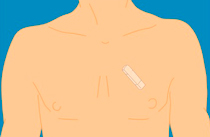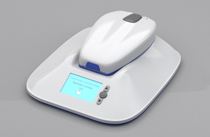Continuous Recording of Heart Rate Can Be Used to Obtain Information
Implantable loop recorders

An implantable loop recorder is a small heart monitor which is fitted under your skin to record the rhythm of your heart for up to three years.
Jump straight to:
- What is an implantable loop recorder?
- Why do I need an implantable loop recorder?
- How does an implantable loop recorder work?
- How do I prepare for an implantable loop recorder procedure?
- How is an implantable loop recorder fitted?
- Are there any risks?
- What can I expect from the recovery?
- What do I do if I am having symptoms?
- How is an implantable loop recorder taken out?
- Can I do day-to-day activities while I have one?
- What do I do when I travel abroad?
- I have questions about my loop recorder, where can I get help?
What is an implantable loop recorder?
An implantable loop recorder (or ILR) is a small, rectangular device that records the electrical activity of your heart. Loop recorders are placed under the skin, usually on the left side of your chest.
There are two types of loop recorders, the traditional ones and the newer ones (you might hear the new ILRs called injectable loop recorders). The main difference is how they are implanted. The newer loop recorders are about 5cm long, the traditional loop recorders range between one to two inches long which is similar to a small pack of chewing gum.
Why do I need an implantable loop recorder?
Sometimes, people experience symptoms such as:
- dizzy spells
- blackouts
- palpitations (when your heart beats very fast, it might feel like it's pounding or fluttering).
These symptoms might happen when you're being active or when you're resting and might not happen very often, but they can feel worrying.
If the cause of your symptoms can't be explained by a routine ECG test or standard heart rhythm monitoring (usually over one or two days), an implantable loop recorder may be suggested by your medical team to see how your heart has been working and find what might be causing your symptoms.
For some people that have had a recent stroke, an ILR might be suggested to them too to find the cause of the stroke, if the standard tests haven't.
How does an implantable loop recorder work?
Loop recorders continuously monitor your heart rate and the rhythm of your heart, like a longer version of the standard heart monitoring tests you may have already had. They pick up the electrical signals from your heart and recognise if your heart rate or rhythm are abnormal. The information is then recorded and stored in its memory for your medical team to review.
When your device recognises something unusual, it will either begin recording your heart's activity automatically, or you might need to:
- manually start the recording using a small, hand-held activator machine when you feel symptoms
- use a mobile phone app to manually record the activity.
If your device needs you to use an activator, hold it over the area of your chest where you ILR is, and it will begin recording. Your healthcare team will tell you if you can use the mobile phone app for your device and how to use it, or show you how to use your activator before you go home. They will also answer any questions you have.
 The recording will either be sent to your medical team automatically using a small bedside monitoring machine you might be given, or you might be asked to go to the hospital clinic where the results can be downloaded. Both options are quick and won't need a procedure, and you will be told which one you need to do.
The recording will either be sent to your medical team automatically using a small bedside monitoring machine you might be given, or you might be asked to go to the hospital clinic where the results can be downloaded. Both options are quick and won't need a procedure, and you will be told which one you need to do.
How do I prepare for an implantable loop recorder procedure?
Your healthcare provider will tell you how to prepare for the procedure to have your loop recorder fitted before the day. The procedure is quick and simple, but you might feel a bit nervous. If you do, your doctor will answer your questions and help with any concerns. During your appointment with your doctor to prepare you for the procedure, you are likely to talk about:
- the type of loop recorder you are going to have fitted
- what you can expect to happen on the day of the procedure
- if you can eat and drink like you normally do on the day of the procedure
- your medication and if you should continue to take it likely you normally do
- how you might feel after the procedure and going home
- any concerns or questions you might have.
How is an implantable loop recorder fitted?
There are two types of implantable loop recorder devices, the traditional one and the newer injectable one. The procedure to fit either type of ILR device takes about 10 to 15 minutes and it will usually happen in an outpatient setting. For the traditional loop recorder, you can normally expect the following:
- you will be given a local anaesthetic to numb the area, this means you will be awake, but you won't feel any pain
- a small cut (roughly two centimetres) will be made on the upper left side of your chest
- the implantable loop recorder will be placed under the skin
- the cut will typically be closed with either a special type of glue or a couple of stitches if needed.
For the newer injectable loop recorder, you can normally expect the following:
- you will be given a local anaesthetic to numb the area, this means you will be awake, but you won't feel any pain
- a small cut (roughly one centimetre) will be made on the mid left side of your chest
- the implantable loop recorder will be injected under the skin
- the cut will typically be closed with either a special type of glue or a couple of stitches if needed.
Are there any risks?
The procedure is simple and very common, many people have a heart monitor fitted every day. The risks are low but as with any procedure, there are risks such as bleeding, bruising and infection.
There is also a small chance of the device moving a little bit on the left side of your chest. The device can move slightly because it isn't secured in a set position. It is okay for your device to move slightly as long as it doesn't feel uncomfortable, and it can still record your heart's activity. Most people who notice that their device has moved slightly won't feel any discomfort. If your device feels uncomfortable or you are worried about the movement, contact your healthcare team.
For some people the risks can be worrying, if you are concerned you can talk to your doctor about it before your loop recorder is fitted. Your doctor will understand your concerns and be able to answer any questions you might have. They will explain the risks to you before you give your consent to have the loop recorder fitted.
Your healthcare provider will also tell you what symptoms to look out for after your procedure, like signs of infection, and who to contact if you experience any symptoms that worry you in your recovery.
What can I expect from the recovery?
If you feel well (your chest may feel a bit bruised or sore) you can go home and spend the rest of the day as you normally would. You may need to limit your upper body movement for a few days to allow your cut and any bruising to heal. You may need to keep the dressing over your cut on and keep it dry for around one week.
When your doctor is happy for you to go home, they will give you all the information you need to know about the type of ILR you have as well as the manufacturer information. You may also be given a hand-held activator and a bedside monitor if your device needs it, your doctor will talk you through the steps on how and when to use them. They will also answer any questions you might have about your recovery.
What do I do if I am having symptoms?
Once your ILR has been fitted, if you feel symptoms such as very fast or slow heartbeats or feeling dizzy, try to relax and if possible, follow the steps your healthcare provider will have told you to do when this happens. Depending on the type of loop recorder you have, you might need to use your hand-held activator.
When you feel symptoms and you have your activator with you:
- place the activator over the implantable loop recorder on the left side of your chest
- press the button on the activator to begin the recording.
Usually, the activator can record the rhythm of your heart in the few minutes before you start the recording too.
How is an implantable loop recorder taken out?
The device will be removed much in the same way it was implanted. A small cut will be made along the original scar using local anaesthetic.
You will have the procedure to take out your device once a diagnosis has been made or if your loop recorder's battery life has come to an end and needs to be changed. Each device can be used for up to three years, a new implantable loop recorder can be fitted at the same time if necessary.
Can I do day-to-day activities while I have one?
When you have an implantable loop recorder, you will be able to do everything you normally would, like go to work or the gym. If your symptoms before your ILR was fitted didn't stop you from driving, playing sports or using equipment, you will be allowed to do those activities once your ILR is fitted.
Once your ILR is fitted and you return to your day-to-day activities, if you feel any symptoms, make a note of what you were doing, where it happened and when, and use your hand-held activator if you have it with you.
What do I do when I travel abroad?
You can go abroad like you normally would with a heart monitor. You will be given a device identification card which you should carry with you when you travel. You can go through airport security scanners safely, but you may need to show your card if you set off the metal detectors.
If you were given a bedside monitor to keep at home, take this with you and keep it by your bedside as you would at home, if possible.
I have questions about my loop recorder, where can I get help?
If you have questions about your implantable loop recorder, your activator, or your bedside monitor, you can refer to the information booklet that will come with your devices for answers, or you can contact your medical team.
Want to know more?
Dr Paul Scott, a Cardiologist at King's College Hospital, explains the importance of using heart monitors, what implantable loop recorders do and when you might need one.
Read Dr Scott's advice
You can trust our health information
We've followed an eight-step process to make sure this content is reliable, accurate and trustworthy. Learn how we make our health information reliable and easy to understand.

Page last reviewed: August 2021
Next review due: August 2024
Want to know more?
Order or download our publications:


Source: https://www.bhf.org.uk/informationsupport/tests/implantable-loop-recorders
0 Response to "Continuous Recording of Heart Rate Can Be Used to Obtain Information"
Postar um comentário